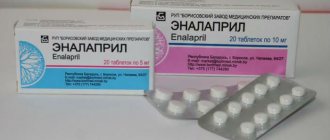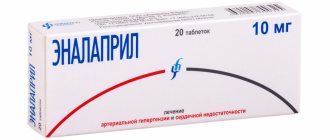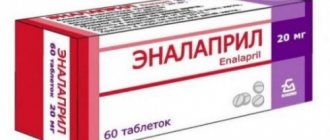Enalapril+Hydrochlorothiazide Renipril GT tablet 12.5 mg+10 mg x20
Trade name: Renipril HT International name: Hydrochlorothiazide + Enalapril
Release form: tablets (blister packs)
Composition: enalapril maleate 10 mg, hydrochlorothiazide 12.5 mg
Pharmacological group: combined antihypertensive drug (ACE inhibitor + diuretic)
Pharmacological group according to ATK: C09BA02 (Enalapril in combination with diuretics)
Pharmacological action: vasodilating, hypotensive, diuretic, ACE blocking,
Indications: Arterial hypertension, CHF.
Dosage regimen: Orally, regardless of food intake, 1-2 tablets 1 time per day (in patients with a decrease in glomerular filtration to 30 ml/min, individual dose selection is required, in terms of enalapril - 5-10 mg/day).
Contraindications: Hypersensitivity (including to other sulfonamide derivatives), anuria, history of angioedema associated with taking ACE inhibitors, hereditary or idiopathic angioedema
pregnancy, lactation period, childhood.
Side effects: Most often: dizziness, increased fatigue.
1-2%: muscle cramps, nausea, asthenia, orthostatic hypotension, headache, cough, impotence.
From the cardiovascular system: fainting, decreased blood pressure, palpitations, tachycardia, chest pain.
Allergic reactions: angioedema (face, tongue, lips, vocal cords, larynx, extremities, intestines), malignant exudative erythema (Stevens-Johnson syndrome).
From the nervous system: dizziness, insomnia or drowsiness, paresthesia, increased excitability.
From the respiratory system: shortness of breath.
From the digestive system: dry mouth, dyspepsia (including nausea, vomiting, flatulence), diarrhea or constipation, abdominal pain, pancreatitis.
From the genitourinary system: impaired renal function, renal failure, decreased libido.
From the skin: skin rash, itching, sweating.
Laboratory indicators: hyperglycemia, hyper- or hypokalemia, increased urea concentration in blood serum, hypercreatininemia, hyperuricemia, increased activity of “liver” transaminases, hyperbilirubinemia, decreased Hb and hematocrit.
Other: gout, tinnitus, arthralgia, lupus-like syndrome (fever, serositis, vasculitis, myalgia/myositis, arthralgia/arthritis, positive test for antinuclear antibodies, increased ESR, eosinophilia, leukocytosis, skin rash, photosensitivity).
Overdose Symptoms: excessive decrease in blood pressure up to the development of collapse, myocardial infarction, acute cerebrovascular accident or thromboembolic complications, convulsions, stupor. Treatment: gastric lavage, ingestion of saline solution, intravenous administration of plasma substitutes, angiotensin II, hemodialysis (excretion rate - 62 ml/min).
Pharmacodynamics: A combined drug, the effect of which is determined by the components included in its composition, has a hypotensive effect. Hydrochlorothiazide is a medium-strength diuretic that increases urinary excretion of Na+, Cl-, water, and bicarbonate. A decrease in Na+ concentration in the wall of blood vessels leads to their dilatation and reduces sensitivity to vasoconstrictor factors. Enalapril inhibits ACE, which promotes the conversion of angiotensin I to angiotensin II, reduces the concentration of aldosterone in the blood, increases the release of renin, improves the functioning of the kallikrein-kinin vasodepressive system, stimulates the release of Pg and venous endothelial relaxing factor, and inhibits the sympathetic nervous system. Together, these effects eliminate spasm and dilate peripheral arteries, reduce peripheral vascular resistance, systolic and diastolic blood pressure, post- and preload on the myocardium.
Hydrochlorothiazide reduces the level of K+ in the blood, enalapril causes its delay, and when these drugs are used together, normal maintenance of the concentration of K+ in the blood is ensured.
Special instructions: Therapy should be discontinued before testing the function of the parathyroid glands. Subject to dialysis. Dosage adjustments on days when dialysis is not performed should be based on blood pressure levels. Before and during treatment, monitoring of blood pressure, renal function, and plasma K+ concentration is necessary.
Caution must be exercised when prescribing to patients with reduced blood volume (as a result of diuretic therapy, limiting salt intake, hemodialysis, diarrhea and vomiting) due to the increased risk of sudden hypotension after using even the initial dose. Transient hypotension is not a contraindication for continuing treatment with the drug after stabilization of blood pressure. If severe hypotension reoccurs, the dose should be reduced or the drug discontinued.
In case of excessive hypotension, the patient is transferred to a horizontal position with a low head, and, if necessary, a 0.9% NaCl solution is administered (to increase plasma volume). Patients with decompensated CHF, ischemic heart disease and cerebral vascular diseases should be monitored, in whom a sharp decrease in blood pressure can lead to myocardial infarction or stroke, or impaired renal function.
The use of AN69 dialysis membranes in combination with ACE inhibitors is not recommended.
With caution Renal/liver failure, severe systemic connective tissue diseases (including SLE, scleroderma), bilateral renal artery stenosis, stenosis of the artery of a single kidney, condition after kidney transplantation, aortic stenosis, CHF, coronary artery disease, suppression of bone marrow hematopoiesis, cerebrovascular diseases (including cerebrovascular insufficiency), diabetes mellitus, hyperkalemia, Na+-restricted diet, conditions accompanied by a decrease in blood volume (including diarrhea, vomiting), old age.
Interaction: The hypotensive effect is reduced by NSAIDs, estrogens, ethanol, increased by diuretics, drugs for general anesthesia, antihypertensive drugs, hemodialysis.
Immunosuppressants, allopurinol, and cytostatics increase the risk of developing hematotoxicity.
Enhances the effect of ethanol and slows down the excretion of Li+.
Simultaneous administration with beta-blockers and BMCC increases the risk of developing hypotension.
Drug registration number: P No. 000156/01
Date of registration (re-registration) of the drug: November 25, 2004
Renipril® HT
During therapy with Renipril® GT, the patient's condition should be regularly monitored, especially at the beginning of treatment.
Arterial hypotension and
electrolyte imbalance
When using antihypertensive drugs, some patients may develop symptomatic arterial hypotension (even several hours after taking the first dose). Patients should be monitored for clinical signs of fluid and electrolyte imbalance, such as dehydration, hyponatremia, hypochloremic alkalosis, hypomagnesemia, or hypokalemia, which may occur with concomitant diarrhea or vomiting. In such patients, monitoring of serum electrolytes is necessary. The drug should be prescribed with extreme caution to patients with coronary artery disease or cerebrovascular diseases, in whom a pronounced decrease in blood pressure can lead to myocardial infarction and/or stroke.
If arterial hypotension develops, the patient should be laid down, legs elevated and, if necessary, a 0.9% sodium chloride solution should be administered. Transient arterial hypotension when taking Renipril® GT is not a contraindication to its further use. After normalization of blood pressure and replenishment of blood volume, therapy can be resumed in lower doses or each of the components of the drug can be used in monotherapy.
Aortic or mitral stenosis/HOCM
As with all drugs that have a vasodilating effect, ACE inhibitors should be administered with caution to patients with left ventricular outflow tract obstruction.
Renal dysfunction
The drug should not be prescribed to patients with renal failure (creatinine clearance less than 80 ml/min) until the selection of individual components of the drug shows that the required doses are present in this dosage form. In some patients with arterial hypertension, without any evidence of a history of kidney disease, when treated with enalapril in combination with a diuretic, a slight and transient increase in plasma urea and serum creatinine concentrations may occur; in such cases, treatment with Reniprilk® GT should be discontinued . In the future, it is possible to resume therapy in lower doses or each of the components of the drug can be used in monotherapy.
In some patients with bilateral renal artery stenosis and stenosis of the artery of a solitary kidney, when treated with ACE inhibitors, an increase in the concentration of urea in the blood plasma and creatinine in the serum was observed, these changes were usually reversible, as a rule, the indicators returned to normal after cessation of therapy. This pattern of changes is most likely in patients with impaired renal function.
When using ACE inhibitors for renovascular arterial hypertension, there is also a high risk of a pronounced decrease in blood pressure, so treatment in such patients begins with a low dose of Renipril® GT under the supervision of a physician.
Liver failure
Rarely, when treated with ACE inhibitors, a syndrome is observed that begins with cholestatic jaundice or hepatitis, which progresses to fulminant liver necrosis, sometimes with death. The mechanism of this syndrome has not been studied. Patients who develop jaundice or a marked increase in the activity of liver transaminases during treatment with ACE inhibitors should discontinue the ACE inhibitors and prescribe appropriate auxiliary therapy. The patient must be under medical supervision.
Surgery/general anesthesia
During major surgery or general anesthesia with the use of drugs that cause an antihypertensive effect, enalaprilat blocks the formation of angiotensin II caused by the compensatory release of renin. If a pronounced decrease in blood pressure develops, explained by a similar mechanism, it can be corrected by increasing the volume of blood volume. It is necessary to warn the surgeon/anesthesiologist that the patient is taking ACE inhibitors.
Hypersensitivity reactions/angioedema
When using ACE inhibitors, including enalapril, in rare cases and during any period of therapy, the development of angioedema of the face, upper and lower extremities, lips, mucous membranes, tongue, vocal folds and/or larynx may be observed (see section “Adverse reactions”). action"). If symptoms appear, the drug should be stopped immediately and the patient should be observed until signs of edema completely disappear. If the swelling affects only the face and lips, it usually resolves on its own, although antihistamines may be used to treat symptoms.
Angioedema, accompanied by swelling of the larynx, can be fatal. Swelling of the tongue, vocal folds, or larynx can lead to airway obstruction. When such symptoms appear, emergency treatment is required, including subcutaneous administration of epinephrine (adrenaline) and/or ensuring airway patency. The patient should be under medical supervision until symptoms disappear completely and permanently.
In patients of negroid
races taking ACE inhibitors, angioedema developed more often than in patients of other races.
Patients with a history of angioedema not associated with taking ACE inhibitors may be at greater risk of developing angioedema during therapy with ACE inhibitors (see section "Contraindications").
In patients taking ACE inhibitors and mammalian target of rapamycin (mTOR) inhibitors, estramustine, racecadotril, gliptins, an increased risk of developing angioedema was observed (see section "Interaction with other drugs").
In patients taking thiazide diuretics, hypersensitivity reactions may occur even in the absence of a history of allergic reactions or bronchial asthma. Relapses and worsening severity of systemic lupus erythematosus have been reported in patients taking thiazide diuretics.
In rare cases, intestinal edema develops during therapy with ACE inhibitors. In this case, patients experience abdominal pain as an isolated symptom or in combination with nausea and vomiting, in some cases without previous angioedema of the face and with normal levels of C1-esterase. The diagnosis was made using abdominal computed tomography, ultrasound, or surgery. Symptoms disappeared after stopping the ACE inhibitors. Therefore, in patients with abdominal pain receiving ACE inhibitors, when carrying out differential diagnosis, it is necessary to take into account the possibility of developing angioedema of the intestine (see section “Side effects”).
Anaphylactoid reactions during desensitization with an allergen from Hymenoptera venom
In rare cases, patients taking ACE inhibitors have developed life-threatening anaphylactoid reactions during desensitization with hymenoptera venom allergen. To avoid corresponding reactions, ACE inhibitor therapy should be temporarily discontinued before each desensitization therapy session.
Anaphylactoid reactions during low-density lipoprotein (LDL) apheresis
In rare cases, life-threatening anaphylactoid reactions may occur in patients receiving ACE inhibitors during LDL apheresis using dextran sulfate. To prevent an anaphylactoid reaction, ACE inhibitor therapy should be temporarily discontinued before each LDL apheresis procedure.
Patients on hemodialysis
It should be borne in mind that when treated with Renipril® GT in patients who are indicated for hemodialysis, the development of anaphylactoid reactions (swelling of the face, flushing of the skin, marked decrease in blood pressure, shortness of breath) is possible due to the use of high-throughput filter membranes consisting made of polyacrylonitrile (for example, high-flow membranes AN69®). It is recommended to use other types of dialysis membranes for hemodialysis or other classes of antihypertensive agents.
Kidney transplant
There is no experience with the use of enalapril in patients after kidney transplantation. Treatment with enalapril in patients after kidney transplantation is not recommended.
Neutropenia/agranulocytosis
There are reports of the development of neutropenia/agranulocytosis, thrombocytopenia and anemia in patients receiving treatment with ACE inhibitors. The risk of neutropenia likely depends on the dose and the clinical condition of the patient. Neutropenia may occur more often in patients with reduced renal function, especially if there is a concomitant connective tissue disease (systemic lupus erythematosus, scleroderma) or when treated with immunosuppressants, allopurinol or procainamide, as well as a combination of these complicating risk factors. Some of these patients developed severe infectious diseases, which in some cases did not respond to intensive antibiotic therapy. When using enalapril in such patients, it is advisable to carry out monitoring of blood leukocytes and a complete blood count before treatment, every 2 weeks in the first three months of treatment, and then regularly. The patient should be strongly advised to report any symptom of an infectious disease (eg, sore throat, fever) to the doctor; in this case, the leukocyte blood count should be monitored. If neutropenia (less than 1000/mm3) is suspected or detected, which is reversible, the drug Renipril® GT and other drugs taken simultaneously should be discontinued (see section “Interaction with other drugs”).
Double blockade of the RAAS
Cases of hypotension, syncope, stroke, hyperkalemia and renal dysfunction (including acute renal failure) have been reported in susceptible patients, especially when used concomitantly with drugs that affect this system. Therefore, double blockade of the RAAS by combining an ACE inhibitor with an ARA II or aliskiren is not recommended.
Combination with aliskiren is contraindicated in patients with diabetes mellitus and/or moderate or severe renal impairment (GFR less than 60 ml/min/1.73 m2 body surface area) (see sections “Contraindications” and “Interaction with other drugs”) . The simultaneous use of ACE inhibitors and ARB II is contraindicated in patients with diabetic nephropathy and is not recommended in other patients.
Lithium preparations
The simultaneous use of lithium, enalapril and diuretics is not recommended (see section “Interaction with other drugs”).
Cough
Cough may occur during therapy with ACE inhibitors. As a rule, this is a dry cough, is permanent and disappears after stopping treatment. Cough associated with the use of ACE inhibitors should be considered in the differential diagnosis of cough.
Hyperkalemia
(see section "Interaction with other drugs")
During treatment with Renipril® GT, an increase in potassium levels in the blood serum is possible, especially in patients with chronic renal failure, diabetes mellitus, with simultaneous use of potassium-sparing diuretics (for example, spironolactone, eplerenone, amiloride, triamterene), potassium supplements or potassium-containing salt substitutes, as well as in patients taking other drugs that lead to an increase in potassium levels in the blood serum (for example, heparin); this effect is usually attenuated by thiazide diuretics due to increased potassium excretion. If the simultaneous use of the above drugs is necessary, then regular monitoring of potassium levels in the blood serum is recommended (see section “Interaction with other drugs”).
Metabolic and endocrine effects
Thiazide therapy may impair glucose tolerance. It may be necessary to adjust the dose of insulin or oral hypoglycemic agents (see section “Interaction with other drugs”). When treated with thiazides, latent diabetes mellitus can manifest itself.
Thiazides can reduce the excretion of calcium by the kidneys and cause a transient increase in serum calcium without visible disturbances in its metabolism. Severe hypercalcemia may be a sign of latent hyperparathyroidism. Due to the effect of thiazides on calcium metabolism, their use may distort the results of testing the function of the parathyroid glands, therefore, before testing the function of the parathyroid glands, the thiazide diuretic should be discontinued.
Increases in plasma cholesterol and triglyceride concentrations may also be associated with thiazide diuretic therapy.
In some patients, therapy with thiazide diuretics may lead to the development of hyperuricemia and/or exacerbation of gout. However, enalapril may increase renal excretion of uric acid and thereby reduce the hyperuricemic effect of hydrochlorothiazide.
Liver diseases
Thiazide diuretics should be used with caution in patients with impaired liver function and/or progressive liver disease, since even small changes in water and electrolyte balance can lead to hepatic coma.
Anti-doping test
Hydrochlorothiazide may cause a positive result during doping control.
Acute myopia and closed-angle glaucoma
Hydrochlorothiazide, being a sulfonamide derivative, can cause an idiosyncratic reaction in the form of acute transient myopia and acute secondary angle-closure glaucoma. Symptoms include: sudden loss of visual acuity or eye pain, usually occurring within hours to weeks of starting hydrochlorothiazide therapy. If left untreated, acute angle-closure glaucoma can lead to permanent vision loss. Treatment: Stop taking hydrochlorothiazide as soon as possible. If intraocular pressure remains uncontrolled, emergency medical treatment or surgery may be required. Risk factors for the development of acute angle-closure glaucoma are: a history of an allergic reaction to sulfonamides or penicillin.
Non-melanoma skin cancer
Two pharmacoepidemiological studies using data from the Danish National Cancer Registry demonstrated an association between hydrochlorothiazide use and an increased risk of non-melanoma skin cancer (NMSC) basal cell carcinoma and squamous cell carcinoma. The risk of developing NMSC increased with increasing total (cumulative) dose of hydrochlorothiazide. A possible mechanism for the development of NMSC is the photosensitizing effect of hydrochlorothiazide.
Patients taking hydrochlorothiazide as monotherapy or in combination with other drugs should be aware of the risk of developing NMSC. It is recommended that such patients undergo regular skin examination to identify any new suspicious lesions as well as changes in existing skin lesions.
Any suspicious skin changes should be reported to your doctor immediately. Suspicious areas of skin should be examined by a specialist. To clarify the diagnosis, histological examination of skin biopsies may be required.
To minimize the risk of developing NMSC, patients should be advised to follow preventive measures, such as limiting exposure to sunlight and UV rays, and using appropriate protective equipment.
In patients with a history of non-melanoma skin cancer, it is recommended to reconsider the use of hydrochlorothiazide.


